Discover 6 hidden attractions, cool sights, and unusual things to do in Katmai National Park (United States). Don't miss out on these must-see attractions: Brooks Falls, Brooks Camp, and Brooks River Historic Ranger Station. Also, be sure to include Naknek Lake in your itinerary.
Below, you can find the list of the most amazing places you should visit in Katmai National Park (Alaska).
Table of Contents
Brooks Falls
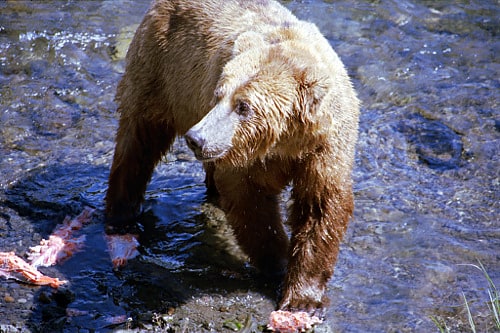
Waterfall in Alaska. Brooks Falls is a waterfall located within Katmai National Park and Preserve in Alaska. Located on the Brooks River a mile and a half from Brooks Lake and an equal distance from Naknek Lake, the falls are famous for watching salmon leap over the 6 foot falls to get to their Brooks Lake spawning grounds. Consequently, large populations of brown bears, also called grizzly bears, are attracted to feed on the spawning salmon. Brown bears usually congregate at the falls in July through early September, and many well-known photos of bears have been taken there. July witnesses the greatest concentrations of bears of any month at the falls; up to 25 bears have been seen at one time at Brooks Falls in that month. In September, a smaller number of bears can be seen at the falls to feast on the later salmon runs.[1]
Brooks Camp
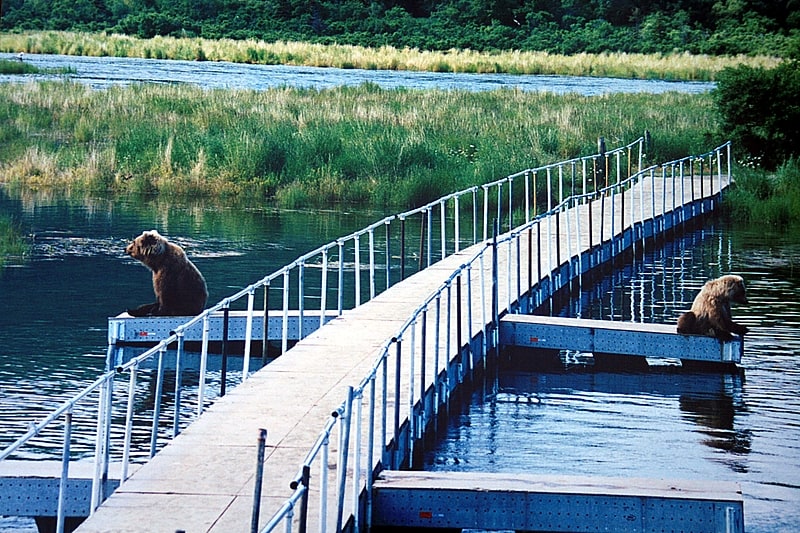
Housing. Brooks Camp is a visitor attraction and archeological site in Katmai National Park and Preserve, noted for its opportunities for visitors to observe Alaskan brown bears catching fish in the falls of the Brooks River during salmon spawning season. The Brooks River connects Lake Brooks and Naknek Lake over about 2 kilometres. This natural choke point for salmon runs made it an attractive location for prehistoric Alaskans, who occupied the area from 4500 BP. The Aglegmuit people lived along the Brooks River in historical times. The Brooks River Archeological District, which includes Brooks Camp, was designated a National Historic Landmark in 1993.
The original name for the lake was Ketivik, or Qit'rwik, which means "beavers broke their houses a long time ago," or alternatively, "sheltered place behind a point." Brooks Lake and Brooks River were named in 1919 by Robert Fiske Griggs, after Alfred Hulse Brooks, the geologist in charge of exploring and mapping the Territory of Alaska.
Five thousand years before present the level of Naknek Lake was significantly higher, and Lake Brooks was part of Naknek. As the Naknek River cut through glacial moraines, the level of Naknek Lake fell, creating Lake Brooks and the Brooks River. Permanent habitation was established along the river about 4000 years ago. The area was inhabited when the first Russian explorers reached what is now Brooks Camp in the 18th century. The National Park Service operates a seasonal visitor center at Brooks Camp, with an exhibit of a reconstructed native house built in 1967-68 in the footprint of a documented house site. Visitors arrive at the Lake Brooks Seaplane Base via floatplane. Lodge guests can take a bus tour to the Valley of Ten Thousand Smokes.
The camp was developed in 1950 by Northern Consolidated Airlines, a National Park Service concessionaire who operated a chain of camps in Katmai, served by float planes. Brooks Lodge continues to operate as a concession within the park. Bear viewing season peaks in July, when the salmon are migrating, and in September, when the salmon are dying after spawning and are washing downstream. Peak visitor season is in July.
With encouragement from General Twining, Ray Petersen representing NCA, approached the National Park Service and the Bureau of Land Management in Dec. 1949 to establish four fishing camps, Brooks and Grosvenor on NPS land and Kulik and Battle on BLM land. NCA would provide access to inaccessible areas of the park system, while the NPS saw a way to provide increased visitation under park protection. A five year concession permit was issued in 1950. Ray Petersen explained how he chose the location of his Angler's Paradise Lodges (Brooks, Kulik, Battle and Grosvenor), "We put the camps on the best rivers for rainbow trout. We looked for salmon spawning water that would draw the rainbows." Bo Bennett goes on to explain, "At nearly every place with two lakes and a short salmon-spawning river connecting them, Ray put in a camp." Hence, Brooks Lodge is on the Brooks River connecting Lake Brooks and Naknek Lake. Likewise, Grosvenor Lodge lies between Lake Coville and Lake Grosvenor, Kulik Lodge lies between Nonvianuk Lake and Kulik Lake, while Battle River Lodge lies between Battle Lake and Narrow Cove on Kukaklek Lake. In 1976, a policy of catch and release was implemented in all Angler's Paradise Camps.
The Brooks Camp of 1950 could manage 30 guests who slept in 9 tent cabins, which included wooden floors, windows, doors, screen doors, cots and sleeping bags. Besides providing running water, shower baths, and a large root cellar, the camp provided meals cooked in a 32 by 16 foot kitchen. Brooks Camp had 138 guests in 1950 and 1,082 in 1959.
The NCA erected a red cedar Pan Adobe lodge, 7 cabins, and bath house in 1960. The first bear viewing platform at the falls and a temporary foot bridge across the mouth of Brooks River were constructed in 1981-1982. A 15 year concessionaire agreement was signed between Katmailand, Inc, and the NPS in 1981. Brooks Lodge and dining room were expanded in 1984, and the last of the original camp tent frames were removed in 1985 and 1986. A 40-person Falls Platform was built in 1997. The raised platform to the falls was built in 2000.[2]
Brooks River Historic Ranger Station
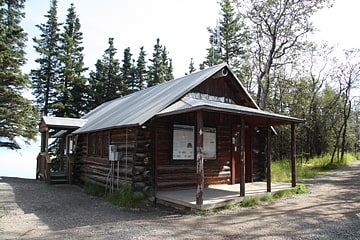
Heritage building in Lake and Peninsula, Alaska. The Brooks River Historic Ranger Station is a log structure located at Brooks Camp in Katmai National Park and Preserve, located on the Alaska Peninsula of southwestern Alaska. It is a single-story building, made out of peeled logs felled in 1954 and assembled in 1955. The building was the first structure built by the National Park Service in Katmai National Park. It was built in part to oversee the growing Brooks Camp facility, which had been built over time by tourism concessionaires.
The building was listed on the National Register of Historic Places in 2010.[3]
Naknek Lake
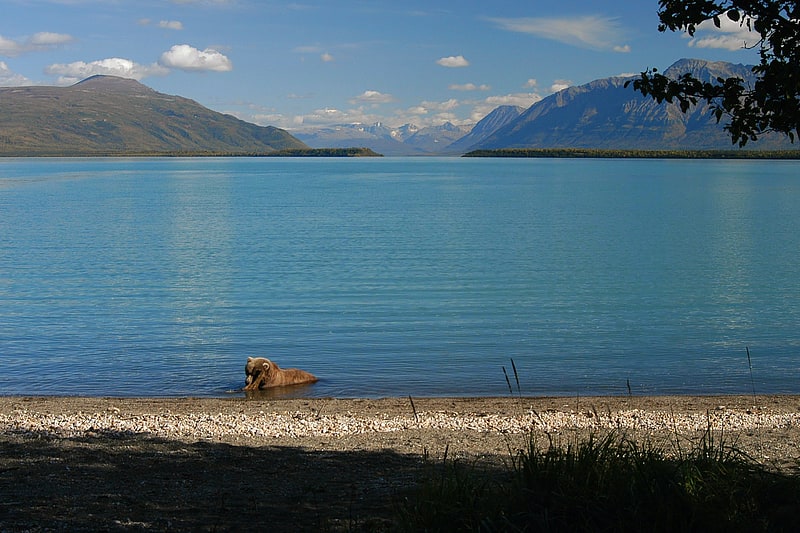
Lake in Alaska. Naknek Lake is a lake in southern Alaska, near the base of the Alaska Peninsula. Located in Katmai National Park and Preserve, the lake is 40 miles long and three to eight miles wide, the largest lake in the park. The lake drains west into Bristol Bay through the Naknek River. The elevation of the lake has lowered over the past 5,000 years as it has cut through a glacial moraine, separating Naknek Lake and Brooks Lake and creating Brooks Falls about 3500 years ago.
The earliest Russian explorer reported the lake's name as Naknek, but a later one said its name was "Akulogak". Ivan Petrof named the lake Lake Walker, for Francis Amasa Walker, Superintendent of the 1880 United States census.
The lake is famous for its sport fishing, supporting one of the largest king salmon fisheries in southwestern Alaska, though the king salmon are greatly outnumbered by sockeye salmon as well as pink and chum salmon. Large rainbow trout are also common around the lake, along with northern pike, lake trout and Arctic char. Brooks Camp is located on the lake's shore where the Brooks River enters the lake over rapids.[4]
Brooks Camp Boat House
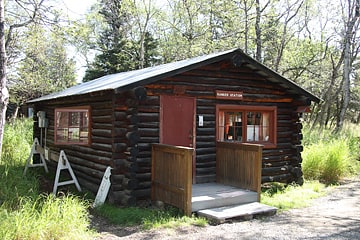
The Brooks Camp Boat House is a historic boathouse at Brooks Camp, a major visitor site in Katmai National Park and Preserve, located on the Alaska Peninsula of southwestern Alaska. The boat house is a simple rectangular log structure with large double-leaf door on the water side, and a door and window on the land side. It was built in 1959 by the National Park Service, and is the second building built in the park by the Park Service. It is used as a ranger station.
The building was listed on the National Register of Historic Places in 2010.[5]
Amalik Bay Archeological District
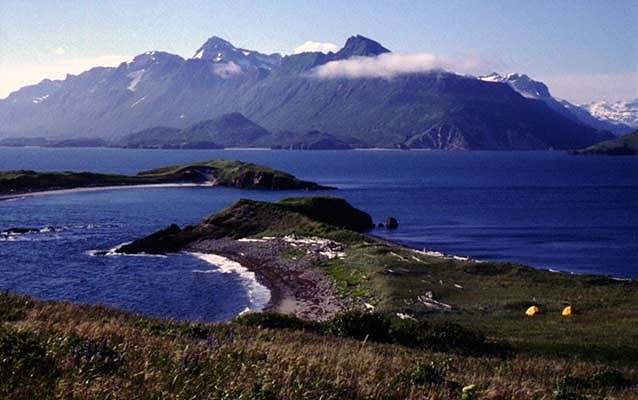
The Amalik Bay Archeological District is a geographic area with a significant number of archaeological sites in Alaska. It is located on the Pacific coast of Katmai National Park and Preserve, in the mainland portion of Kodiak Island Borough, Alaska.
The most important site in the bay is on Mink Island, which contains evidence of human habitation from 7,300 to 500 years ago, and is one of the oldest known places of human habitation on the Alaska Peninsula. The site is located on the shore of the island and is subject to erosive tides; the National Park Service has installed a revetment to protect the site. The site has extremely well-preserved stratigraphy showing occupation sites and dietary evidence. The district was designated a National Historic Landmark and listed on the National Register of Historic Places in 2005.[6]